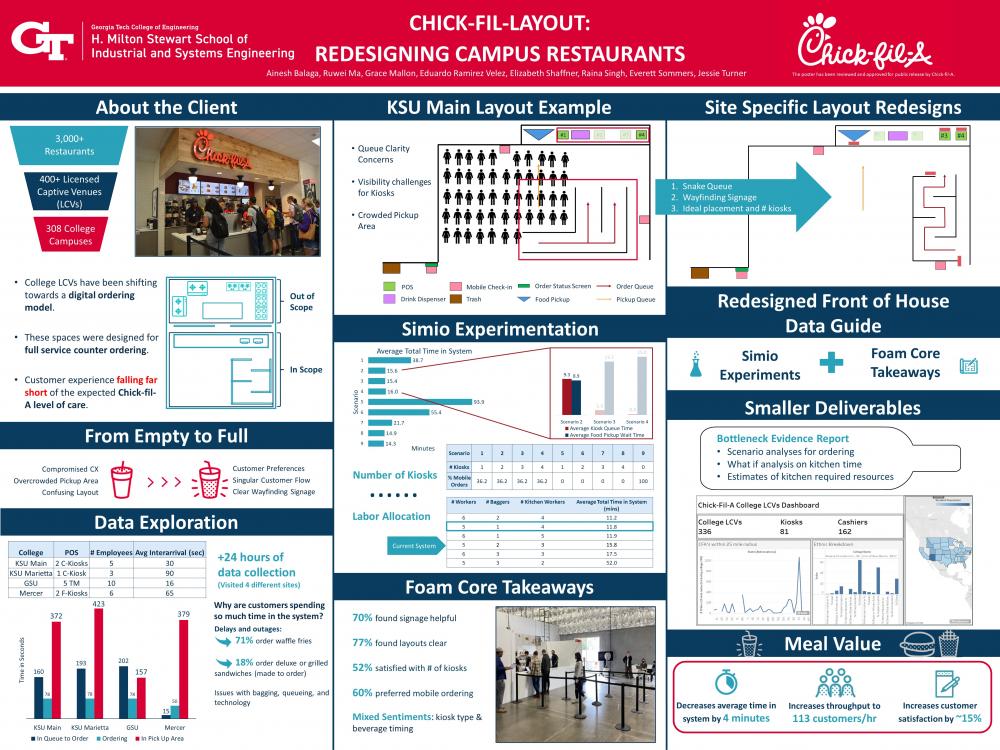Client Context
Chick-fil-A (CFA) is a fast food restaurant known for their chicken sandwich and their customer service. With 3000 restaurants, CFA generated over $9 billion in annual sales in 2022. Over 400 of these 3000 restaurants are licensed captive venues (LCVs), meaning they are franchised restaurants run by a third party operator and they are located inside a bigger venue, such as an airport, stadium, or hospital. 308 of these LCVs are located within college campuses. These college LCVs have been shifting towards a digital ordering model, using kiosks and mobile ordering rather than having customers order with a team member at the front counter.
Project Objective
Because college LCVs were originally designed for full service counter ordering, the implementation of kiosks and mobile ordering has resulted in customer experience falling short of the expected CFA level of care. The restaurant front of house is overcrowded and hard to follow; there is no clear customer flow and customers struggle to receive help from CFA team members when they need it. There is an opportunity to improve customer experience by redesigning the front of house layouts for these college LCVs.
Design Strategy
Site visits were conducted at four college LCVs that were representative of all 308 due to their varied implementations of kiosk and mobile ordering. These site visits were done to collect system time data, customer surveys, and understand the qualitative issues the systems were facing. (The kitchen and food preparation processes were out of scope for this project, but some data was collected regarding the bagging processes and food outages.) The data was used to create a queuing model to understand the system on a technical level and also used in creating Simio models for each restaurant. The Simio models also utilized information gathered from operator interviews. These models were validated with t-tests, Q-Q plots, and density histograms. Experiments were conducted on the Simio models to determine how the number of kiosks, labor allocation between the bagging and kitchen staff, and food preparation processing times affected the overall time in system for customers. Qualitative changes such as additional signage, kiosk placement, and queuing arrangements were tested in a foam core session at CFA’s headquarters with college student volunteers to understand how changes would be received by the customer base. Redesigned front of house layouts were created by addressing each of the qualitative space and customer journey issues observed during the site visits and utilizing the information learned from the Simio experiments and foam core session.
Deliverables
This project resulted in the creation of 4 deliverables:
- 4 Site Specific Layouts: Redesigned front of house layouts were created for each site that was visited throughout the project – Kennesaw State University’s Main and Marietta campuses, Georgia State University, and Mercer University.
- Redesigned Front of House Data Guide: The information gained from the Simio experimentation and foam core session is summarized in this document for CFA add to their knowledge base regarding college LCV customers. The process by which the site specific layouts were created is also documented here so CFA can replicate it at other college LCVs.
- Bottleneck Evidence Report: Initial site visit surveys and observations found a connection between food wait times and customer experience. To decrease food wait times, the kitchen processing time must be improved. That was out of scope for this project, but this report contains an argument for CFA to explore the kitchen at college LCVs as well as general findings from observations concerning waffle fry outages and make to order entrees.
- College LCV Dashboard: Information about other college LCVs and their university characteristics was gathered throughout the course of the project. That data is centralized in this dashboard, so CFA can understand the commonalities and differences across all college LCV locations.
Value and Impact
If the recommended changes are implemented, there is a potential to decrease the average amount of time a customer spends in the system by 4 minutes. Additionally, customer throughput would increase from 112 to 113 customers per hour. While this sounds like a small increase, annually this could be a potential revenue increase of $18,000 at one restaurant location alone. Similar time and throughput changes are expected for the other three restaurants as well. Finally, customer satisfaction was found to increase by approximately 15% using sentiment analysis on survey responses from the initial site visits compared to the redesigned layouts tested in the foam core session.


